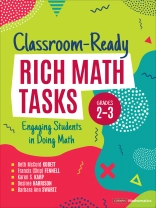Detailed plans for helping elementary students experience deep mathematical learning
Do you work tirelessly to make your math lessons meaningful, challenging, accessible, and engaging? Do you spend hours you don’t have searching for, adapting, and creating tasks to provide rich experiences for your students that supplement your mathematics curriculum? Help has arrived!
Classroom Ready-Rich Math Tasks for Grades 2-3 details research- and standards-aligned, high-cognitive-demand tasks that will have your students doing deep-problem-based learning. These ready-to-implement, engaging tasks connect skills, concepts and practices, while encouraging students to reason, problem-solve, discuss, explore multiple solution pathways, connect multiple representations, and justify their thinking. They help students monitor their own thinking and connect the mathematics they know to new situations. In other words, these tasks allow students to truly do mathematics! Written with a strengths-based lens and an attentiveness to all students, this guide includes:
• Complete task-based lessons, referencing mathematics standards and practices, vocabulary, and materials
• Downloadable planning tools, student resource pages, and thoughtful questions, and formative assessment prompts
• Guidance on preparing, launching, facilitating, and reflecting on each task
• Notes on access and equity, focusing on students’ strengths, productive struggle, and distance or alternative learning environments.
With concluding guidance on adapting or creating additional rich tasks for your students, this guide will help you give all of your students the deepest, most enriching and engaging mathematics learning experience possible.
表中的内容
Chapter 1: Doing-Math Tasks: What Are They, Why Are They Important, and How Do I Plan for Implementation?
Chapter 2: Laying the Groundwork for Teaching With Doing-Math Tasks
Chapter 3: Implementing A Doing-Math Task-Based Lesson
Chapter 4: Operations and Algebraic Thinking – Representing and Solving Problems
Chapter 5: Operations and Algebraic Thinking – Multiplication and Division Foundations
Chapter 6: Operations and Algebraic Thinking: Understanding & Interpreting Operations
Chapter 7: Number and Operations in Base Ten – Using Place Value Understandings
Chapter 8: Number and Operations in Base Ten – Adding, Subtracting, and More
Chapter 9: Number and Operations in Base Ten – Adding, Subtracting, and Multiplying
Chapter 10: Numbers and Operations: Fractions – Partitioning and Representing
Chapter 11: Number and Operations: Fractions – Equivalence, Comparing, and Representing
Chapter 12: Measurement: Time, Money, Length and Weight
Chapter 13: Measurement and Data: Measuring and Representing and Interpreting Data
Chapter 14: Geometric Measurement: Measurement, Perimeter, and Area
Chapter 15: Geometry: Reasoning with Shapes and their Attributes
Chapter 16: Your Turn
Appendix A: Task-Lesson Template
Appendix B: Formative Assessment Tools
References
Index
关于作者
Karen S. Karp is a professor in the School of Education at Johns Hopkins University. Previously, she was a professor of mathematics education in the Department of Early and Elementary Childhood Education at the University of Louisville, where she received the President’s Distinguished Teaching Award and the Distinguished Service Award for a Career of Service. She is a former member of the board of directors of the National Council of Teachers of Mathematics (NCTM) and a former president of the Association of Mathematics Teacher Educators (AMTE). She is a member of the author panel for the What Works Clearinghouse Practice Guide on assisting elementary school students who have difficulty learning mathematics for the U.S. Department of Education Institute of Educational Sciences. She is the author or coauthor of approximately 20 book chapters, 50 articles, and 30 books, including Elementary and Middle School Mathematics: Teaching Developmentally, Developing Essential Understanding of Addition and Subtraction for Teaching Mathematics, and Inspiring Girls to Think Mathematically. She holds teaching certifications in elementary education, secondary mathematics, and K–12 special education.












